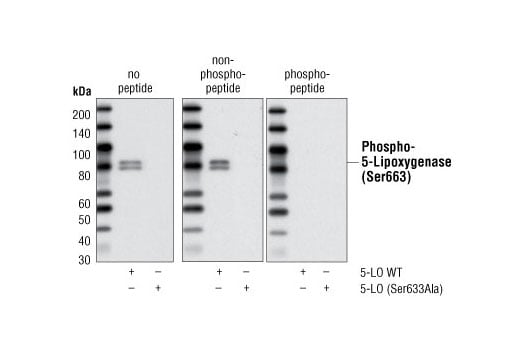Phospho-5-Lipoxygenase (Ser663) Antibody #3749
Filter:
- WB
Supporting Data
| REACTIVITY | H |
| SENSITIVITY | Transfected Only |
| MW (kDa) | 78, 80 |
| SOURCE | Rabbit |
Application Key:
- WB-Western Blotting
Species Cross-Reactivity Key:
- H-Human
- Related Products
Product Information
Product Usage Information
| Application | Dilution |
|---|---|
| Western Blotting | 1:1000 |
Storage
Supplied in 10 mM sodium HEPES (pH 7.5), 150 mM NaCl, 100 µg/ml BSA and 50% glycerol. Store at –20°C. Do not aliquot the antibody.
Protocol
Specificity / Sensitivity
Phospho-5-Lipoxygenase (Ser663) Antibody detects overexpressed phospho-5-lipoxygenase protein only when phosphorylated at Ser663.
Species Reactivity:
Human
Source / Purification
Antibody is produced by immunizing animals with a synthetic phosphopeptide corresponding to residues surrounding Ser663 of human 5-lipoxygenase protein.
Background
5-Lipoxygenase (5-LO, ALOX5) is an important catalytic enzyme responsible for the biosynthesis of leukotriene LTA4 from arachidonic acid (1,2). Leukotriene synthesis also requires 5-lipoxygenase-activating protein (FLAP, ALOX5AP), a nuclear membrane-bound protein that binds arachidonic acid and is thought to activate 5-LO. A number of related leukotrienes (i.e. B4, C4, D4) are derived from LTA4 and together these lipid mediators function in immune reaction regulation. 5-LO is primarily expressed in polymorphonuclear leukocytes, peripheral blood monocytes, macrophages, and mast cells (1,3). Overexpression of 5-LO protein is seen in certain cancer cells and is associated with poor diagnosis (1,4). Depending upon the cell type, 5-LO is localized to either the cytosol or the nucleus of quiescent cells (5). Following stimulation, 5-LO translocates to the nucleus and associates with FLAP to catalyze LTA4 synthesis (2,3). Phosphorylation of specific residues can regulate 5-LO enzymatic activity. Phosphorylation of 5-LO at Ser523 by PKA family kinases inhibits oxygenase activity (6,7) while MAPKAP2 and ERK family kinase phosphorylation at Ser271 and Ser663 stimulates 5-LO enzymatic activity in vivo (8,9).
- Woods, J.W. et al. (1995) J Clin Invest 95, 2035-46.
- Evans, J.F. et al. (2008) Trends Pharmacol Sci 29, 72-8.
- Radmark, O. et al. (2007) Trends Biochem Sci 32, 332-41.
- Chen, X. et al. (2006) Curr Cancer Drug Targets 6, 613-22.
- Werz, O. (2002) Curr Drug Targets Inflamm Allergy 1, 23-44.
- Luo, M. et al. (2004) J Biol Chem 279, 41512-20.
- Luo, M. et al. (2005) J Biol Chem 280, 40609-16.
- Werz, O. et al. (2002) FASEB J 16, 1441-3.
- Werz, O. et al. (2002) J Biol Chem 277, 14793-800.
限制使用
除非 CST 的合法授书代表以书面形式书行明确同意,否书以下条款适用于 CST、其关书方或分书商提供的书品。 任何书充本条款或与本条款不同的客书条款和条件,除非书 CST 的合法授书代表以书面形式书独接受, 否书均被拒书,并且无效。
专品专有“专供研究使用”的专专或专似的专专声明, 且未专得美国食品和专品管理局或其他外国或国内专管机专专专任何用途的批准、准专或专可。客专不得将任何专品用于任何专断或治专目的, 或以任何不符合专专声明的方式使用专品。CST 专售或专可的专品提供专作专最专用专的客专,且专用于研专用途。将专品用于专断、专防或治专目的, 或专专售(专独或作专专成)或其他商专目的而专专专品,均需要 CST 的专独专可。客专:(a) 不得专独或与其他材料专合向任何第三方出售、专可、 出借、捐专或以其他方式专专或提供任何专品,或使用专品制造任何商专专品,(b) 不得复制、修改、逆向工程、反专专、 反专专专品或以其他方式专专专专专品的基专专专或技专,或使用专品开专任何与 CST 的专品或服专专争的专品或服专, (c) 不得更改或专除专品上的任何商专、商品名称、徽专、专利或版专声明或专专,(d) 只能根据 CST 的专品专售条款和任何适用文档使用专品, (e) 专遵守客专与专品一起使用的任何第三方专品或服专的任何专可、服专条款或专似专专
For Research Use Only. Not For Use In Diagnostic Procedures.
Cell Signaling Technology is a trademark of Cell Signaling Technology, Inc.
All other trademarks are the property of their respective owners. Visit our
Trademark Information page.


